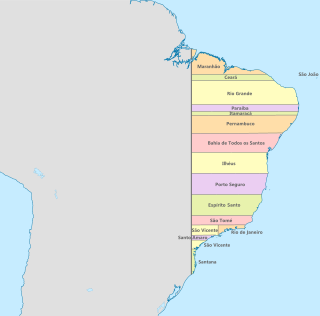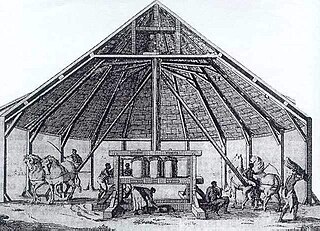Related Research Articles

Colonial Brazil comprises the period from 1500, with the arrival of the Portuguese, until 1815, when Brazil was elevated to a kingdom in union with Portugal as the United Kingdom of Portugal, Brazil and the Algarves. During the early 300 years of Brazilian colonial history, the economic exploitation of the territory was based first on brazilwood extraction, which gave the territory its name; sugar production ; and finally on gold and diamond mining. Slaves, especially those brought from Africa, provided most of the work force of the Brazilian export economy after a brief period of Indian slavery to cut brazilwood.

Sugar plantations in the Caribbean were a major part of the economy of the islands in the 18th, 19th, and 20th centuries. Most Caribbean islands were covered with sugar cane fields and mills for refining the crop. The main source of labor, until the abolition of chattel slavery, was enslaved Africans. After the abolition of slavery, indentured laborers from India, China, Portugal and other places were brought to the Caribbean to work in the sugar industry. These plantations produced 80 to 90 percent of the sugar consumed in Western Europe, later supplanted by European-grown sugar beet.
A plantation economy is an economy based on agricultural mass production, usually of a few commodity crops, grown on large farms worked by laborers or slaves. The properties are called plantations. Plantation economies rely on the export of cash crops as a source of income. Prominent crops included cotton, rubber, sugar cane, tobacco, figs, rice, kapok, sisal, and species in the genus Indigofera, used to produce indigo dye.
Gilberto de Mello Freyre was a Brazilian sociologist, anthropologist, historian, writer, painter, journalist and congressman born in Recife. Considered one of the most important Brazilian sociologists of the 20th century, along with Sérgio Buarque de Holanda and Caio Prado Júnior, his best-known work is a sociological treatise named Casa-Grande & Senzala.

Engenho is a colonial-era Portuguese term for a sugar cane mill and the associated facilities. In Spanish-speaking countries such as Cuba and Puerto Rico, they are called ingenios. Both words mean engine. The word engenho usually only referred to the mill, but it could also describe the area as a whole including land, a mill, the people who farmed and who had a knowledge of sugar production, and a crop of sugar cane. A large estate was required because of the massive amount of labor needed to yield refined sugar, molasses, or rum from raw sugar cane. These estates were prevalent in Brazil, Cuba, Dominican Republic, and other countries in the Caribbean. Today, Brazil is still one of the world's major producers of sugar.

Cachoeira is an inland municipality of Bahia, Brazil, on the Paraguaçu River. The town exports sugar, cotton, and tobacco and is a thriving commercial and industrial centre.

Laranjeiras is a municipality located in the Brazilian state of Sergipe. Its population was 30,080 (2020) and covers 162.27 km2 (62.65 sq mi). Laranjeiras has a population density of 180 inhabitants per square kilometer. Laranjeiras is located 19 km (12 mi) from the state capital of Sergipe, Aracaju. It borders the municipalities of Riachuelo, Areia Branca, Nossa Senhora do Socorro, São Cristóvão, Maruim, and Santo Amaro das Brotas, all within the state of Sergipe. The municipality contains part of the Serra de Itabaiana National Park.
Lusotropicalism is a term and "quasi-theory" developed by Brazilian sociologist Gilberto Freyre to describe the distinctive character of Portuguese imperialism overseas, proposing that the Portuguese were better colonizers than other European nations.

Slavery in Brazil began long before the first Portuguese settlement was established in 1516, with members of one tribe enslaving captured members of another. Later, colonists were heavily dependent on indigenous labor during the initial phases of settlement to maintain the subsistence economy, and natives were often captured by expeditions of bandeirantes. The importation of African slaves began midway through the 16th century, but the enslavement of indigenous peoples continued well into the 17th and 18th centuries.
Racial democracy is a term used by some to describe race relations in Brazil. The term denotes some scholars' belief that Brazil has escaped racism and racial discrimination. Those researchers contend that Brazilians do not view each other through the lens of race and do not harbor racial prejudice towards one another. Because of that, while social mobility of Brazilians may be constrained by many factors, gender and class included, racial discrimination is considered irrelevant.
Casa-Grande e Senzala is a book published in 1933 by Gilberto Freyre, about the formation of Brazilian society. The casa-grande refers to the slave owner's residence on a sugarcane plantation, where whole towns were owned and managed by one man. The Senzala refers to the dwellings of the black working class, where they originally worked as slaves, and later as servants.
The history of Afro-Brazilian people spans over five centuries of racial interaction between Africans imported, involved or descended from the effects of the Atlantic slave trade.

São Francisco do Conde is a municipality in the state of Bahia in the North-East region of Brazil. São Francisco do Conde covers 262.856 km2 (101.489 sq mi), and has a population of 40,245 with a population density of 150 inhabitants per square kilometer. It is located 67 kilometres (42 mi) from the state capital of Salvador. According to the Brazilian Institute of Geography and Statistics São Francisco do Conde has the highest concentration of Brazilians of African descent (90%) in Bahia.

The Captaincy of Pernambuco or New Lusitania was a hereditary land grant and administrative subdivision of northern Portuguese Brazil during the colonial period from the early sixteenth century until Brazilian independence. At the time of the Independence of Brazil, it became a province of United Kingdom of Portugal, Brazil and the Algarves. Captaincies were originally horizontal tracts of land (generally) 50 leagues wide extending from the Atlantic Ocean to the Tordesillas meridian.
Engenho dos Erasmos or Engenho São Jorge dos Erasmos was a sugar cane facility on the island of São Vicente, Brazil. Constructed around 1534, the engenho was owned for most of its working life by the Schetz family. It is now a ruin, national monument and tourist destination.

Slavery in Latin America was an economic and social institution that existed in Latin America from before the colonial era until its legal abolition in the newly independent states during the 19th century. However, it continued illegally in some regions into the 20th century. Slavery in Latin America began in the pre-colonial period when indigenous civilizations, including the Maya and Aztec, enslaved captives taken in war. After the conquest of Latin America by the Spanish and Portuguese, of the nearly 12 million slaves that were shipped across the Atlantic, over 4 million enslaved Africans were brought to Latin America. Roughly 3.5 million of those slaves were brought to Brazil.

Events in the year 1933 in Brazil.

A trapiche is a mill made of wooden rollers used to extract juice from fruit, originally olives, and since the Middle Ages, sugar cane as well. By extension the word is also sometimes applied to the location of the mill, whether the workshop or the entire plantation.
The Tejupeba House and the Chapel of the Colégio Sugar Plantation is a plantation house and chapel in Itaporanga d'Ajuda, Sergipe, Brazil. The church dates to the Jesuit settlement of Santo Ignácio, located in present-day Itaporanga d'Ajuda, in 1575. It is one of many locations cited as the first Jesuits settlement in Portuguese Brazil, and one of many Jesuit slave-holding properties in Latin America. The house and chapel were listed as a historic structure by the National Institute of Historic and Artistic Heritage in 1943. The architectural historian Maria Berthilde Moura Filha stated that "of the remaining sugar plantations in Sergipe, this is the one with the oldest known references."
References
- ↑ Death Without Weeping: The Violence of Everyday Life in Brazil, Nancy Scheper-Hughes, University of California Press, page 37-9
- ↑ At Home in the Street: Street Children of Northeast Brazil, Cambridge University Press, Tobias Hecht, page 155
- ↑ The Repeating Island: The Caribbean and the Postmodern Perspective, Antonio Benitez-Rojo, Duke University Press, page 72
- ↑ The Epic of Latin America, Fourth Edition, University of California Press, John A. Crow, page 385
- ↑ The Epic of Latin America, Fourth Edition, University of California Press, John A. Crow, page 386